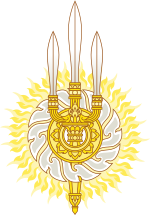泰国君主
泰国君主(华人世界通称为泰国国王,简称泰王,泰语:พระมหากษัตริย์ไทย)为泰国(以前为暹罗)的君主立宪制君主。泰国国王为泰国国家元首,同时也是现今王室扎克里王室的领导者。
| 泰国国王 | |
|---|---|
| พระมหากษัตริย์ไทย | |
 | |
| 现任 | |
 | |
| 玛哈·哇集拉隆功(拉玛十世) 2016年10月13日就任 | |
| 详情 | |
| 尊称 | 陛下 |
| 推定继承人 | 提帮功王子 |
| 开国君主 | 拉玛一世 |
| 建立 | 1782年 |
| 居所 | 曼谷大皇宫(官方) 曼谷律实宫(起居) |
| 泰国王室 |
|---|
 |
|
|
虽然扎克里王朝于1782年才建立,但传统上认为,泰国君主制度起源于1239年的素可泰王国,随后在厄伽陀过世后进入空缺期,直到18世纪拥有华裔血统的郑昭登基才恢复王室。1932年发生不流血的暹罗立宪革命后,泰国君主转型成为君主立宪君主。泰国君主官方住所是位于曼谷的大皇宫;然而,先王普密蓬大帝则是长期居住在吉拉达宫或位于海滩度假城市华欣的忘忧宫,现任国王哇集拉隆功则居住在律实宫。
泰国君主的头衔包含了国家元首、泰国皇家军队统帅、佛教拥护者与宗教维护者[1]。
而其中最伟大的国王称为八大帝,备受人民崇敬,分别是兰甘亨大帝、乌通大帝、纳黎萱大帝、达信大帝、帕佛陀约华朱拉洛大帝(拉玛一世)、蒙固大帝(拉玛四世)、朱拉隆功大帝(拉玛五世)和普密蓬大帝(拉玛九世)。
现任泰王为玛哈·哇集拉隆功(拉玛十世),于2016年10月13日继位。
历史 编辑
起源 编辑
泰国王权的概念,已经演变了800多年,并形成绝对的统治权力。第一位治理统一泰国的君主,是1238年素可泰王国的开国国王室利·膺沙罗铁[3]。早期泰国王权的思想是基于印度教与上座部佛教信仰所衍生出来的概念。印度教的概念是基于刹帝利(泰语:กษัตริย์)的吠陀─印度教种姓制度,或称为武士统治者,王权是由军事力量衍生而来。上座部佛教的概念则来自于“法王”(泰语:ธรรมราชา),而佛教是在约6世纪时引入泰国。法王的概念代表君主必须以“法”与佛陀的教导统治人民。
当1279年兰甘亨大帝登基为王时,原始的概念被短暂替换。他背离了传统并创造出“父权统治”(泰语:พ่อปกครองลูก)的概念取而代之,意思是君主统治人民,就好比父亲教导小孩一样[4][5]。而兰甘亨将他的名字冠以“Pho Khun”的头衔(泰语:พ่อขุนรามคำแหง),用以加强他所创造的概念[6],然而其维持时间非常短暂。在素可泰王国的末期,原始的两个宗教概念回归,并将君主头衔从“Pho Khun”改为“Phaya Khun”。
君主立宪 编辑
1932年不流血政变后,泰国仿效欧洲改为君主立宪制,但国王仍拥有极大影响力,特别是在泰国皇家军队中,保皇派曾发起多起武装政变。
参考文献 编辑
- ^ The Secretariate of the House of Representatives. Constitution of the Kingdom of Thailand B.E 2550 (PDF). The Secretariat of the House of Representatives. Nov 2007 [7 November 2012]. (原始内容 (PDF)存档于2012年8月31日).
- ^ 泰国王室车队遭民众抗议,君主制权威面临挑战. [2020-10-17]. (原始内容存档于2021-02-18).
- ^ Cœdès, G. The Origins of the Sukhodaya Dynasty (PDF). Journal of the Siam Society (Siam Heritage Trust). 1921,. JSS Vol. 14.1b (digital): image 1 [17 March 2013]. (原始内容存档 (PDF)于2016-10-20).
The dynasty which reigned during a part of the XIIIth. and the first half of the XlVth. centuries at Sukhodaya and at Sajjanlaya, on the upper Menam Yom, is the first historical Siamese dynasty. It has a double claim to this title, both because its cradle was precisely in the country designated by foreigners as "Siam" (Khmer: Syain; Chinese : Sien, etc.), and because it is this dynasty which, by freeing the Thai principalities from the Cambodian yoke and by gradually extending its conquests as far as the Malay Peninsula, paved the way for the formation of the Kingdom of Siam properly so called.
- ^ Background to a Modern Kingship. Thai Modern Monarchy. 1998. (原始内容存档于2009-11-02).
- ^ Prince Dhani Nivat, Kromamun Bidyadabh. The Old Siamese conception of the Monarchy (PDF). Journal of the Siam Society (Siamese Heritage Trust). 1947,. JSS Vol. 36.2b (digital): image 10 page 93 [7 March 2013]. (原始内容存档 (PDF)于2016-03-03).
Patriarchal Sukhothai Kingship ...The monarch was of course the people's leader in battle; but he was also in peace-time their father whose advice was sought and expected in all matters and whose judgment was accepted by all. He was moreover accessible to his people, for we are told by an old inscription that, in front of the royal palace of Sukhothai there used to be a gong hung up for people to go and beat upon whenever they wanted personal help and redress. The custom survived with slight modifications all through the centuries down to the change of regime in 1932....
- ^ Terwiel, Barend Jan. Ahom and the Study of Early Thai Society (PDF). Journal of the Siam Society (Siamese Heritage Trust). 1983,. JSS Vol. 71.0 (PDF): image 4 [7 March 2013]. (原始内容 (PDF)存档于2013-11-03).
In older usage, khun was used for a ruler of a fortified town and its surrounding villages, together called a mueang; with the prefix pho (พ่อ "father") appears as Pho Khun.